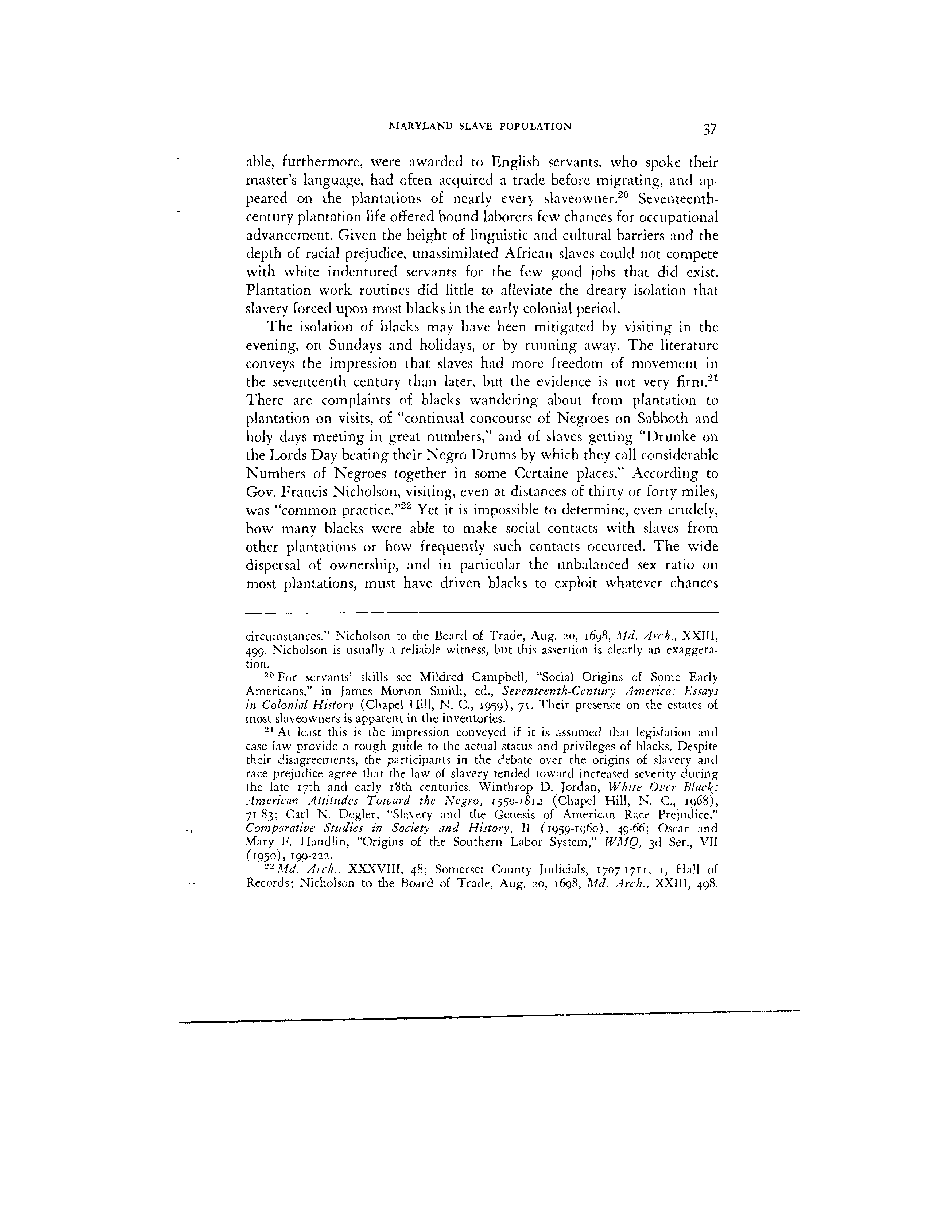|
MARYLAND SLAVE POPULATION 37
able, furthermore, were awarded to English servants, who spoke their
master's language, had often acquired a trade before migrating, and ap-
peared on the plantations of nearly every slaveowner.20 Seventeenth-
century plantation life offered bound laborers few chances for occupational
advancement. Given the height of linguistic and cultural barriers and the
depth of racial prejudice, unassimilated African slaves could not compete
with white indentured servants for the few good jobs that did exist.
Plantation work routines did little to alleviate the dreary isolation that
slavery forced upon most blacks in the early colonial period.
The isolation of blacks may have been mitigated by visiting in the
evening, on Sundays and holidays, or by running away. The literature
conveys the impression that slaves had more freedom of movement in
the seventeenth century than later, but the evidence is not very firm.21
There are complaints of blacks wandering about from plantation to
plantation on visits, of "continual concourse of Negroes on Sabboth and
holy days meeting in great numbers," and of slaves getting "Drunke on
the Lords Day beating their Negro Drums by which they call considerable
Numbers of Negroes together in some Certaine places." According to
Gov. Francis Nicholson, visiting, even at distances of thirty or forty miles,
was "common practice."22 Yet it is impossible to determine, even crudely,
how many blacks were able to make social contacts \vith slaves from
other plantations or how frequently such contacts occurred. The wide
dispersal of ownership, and in particular the unbalanced sex ratio on
most plantations, must have driven blacks to exploit whatever chances
circumstances." Nicholson to the Board of Trade, Aug. 20, 1698, Md. Arch., XXIII,
499. Nicholson is usually a reliable witness, but this assertion is clearly an exaggera-
tion.
20 For servants' skills see Mildred Campbell, "Social Origins of Some Early
Americans," in James Morton Smith, ed., Seventeenth-Century America: Essays
in Colonial History (Chapel Hill, N. C., 1959), 71. Their presence on the estates of
most slaveowners is apparent in the inventories.
21 At least this is the impression conveyed if it is assumed that legislation and
case law provide a rough guide to the actual status and privileges of blacks. Despite
their disagreements, the participants in the debate over the origins of slavery and
race prejudice agree that the law of slavery tended toward increased severity during
ihe late I7th and early i8th centuries. Winthrop D. Jordan, White Over Blac^:
American Attitudes Toward the Negro, 7550-75/2 (Chapel Hill, N. C., 1968),
71-83; Carl N. Degler, "Slavery and the Genesis of American Race Prejudice,"
Comparative Studies in Society and History, II (1959-1960), 49-66; Oscar and
Mary F. Handlin, "Origins of the Southern Labor System," WMO, 3d Ser., VII
(1950), 199-222.
--Md. Arch., XXXVIII, 48; Somerset County Judicials, 1707-1711, r, Hall of
Records; Nicholson to the Board of Trade, Aug. 20, 1698, Md. Arch., XXIII, 498.
�
|

